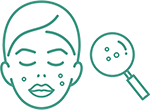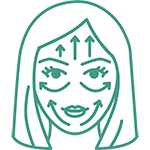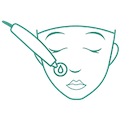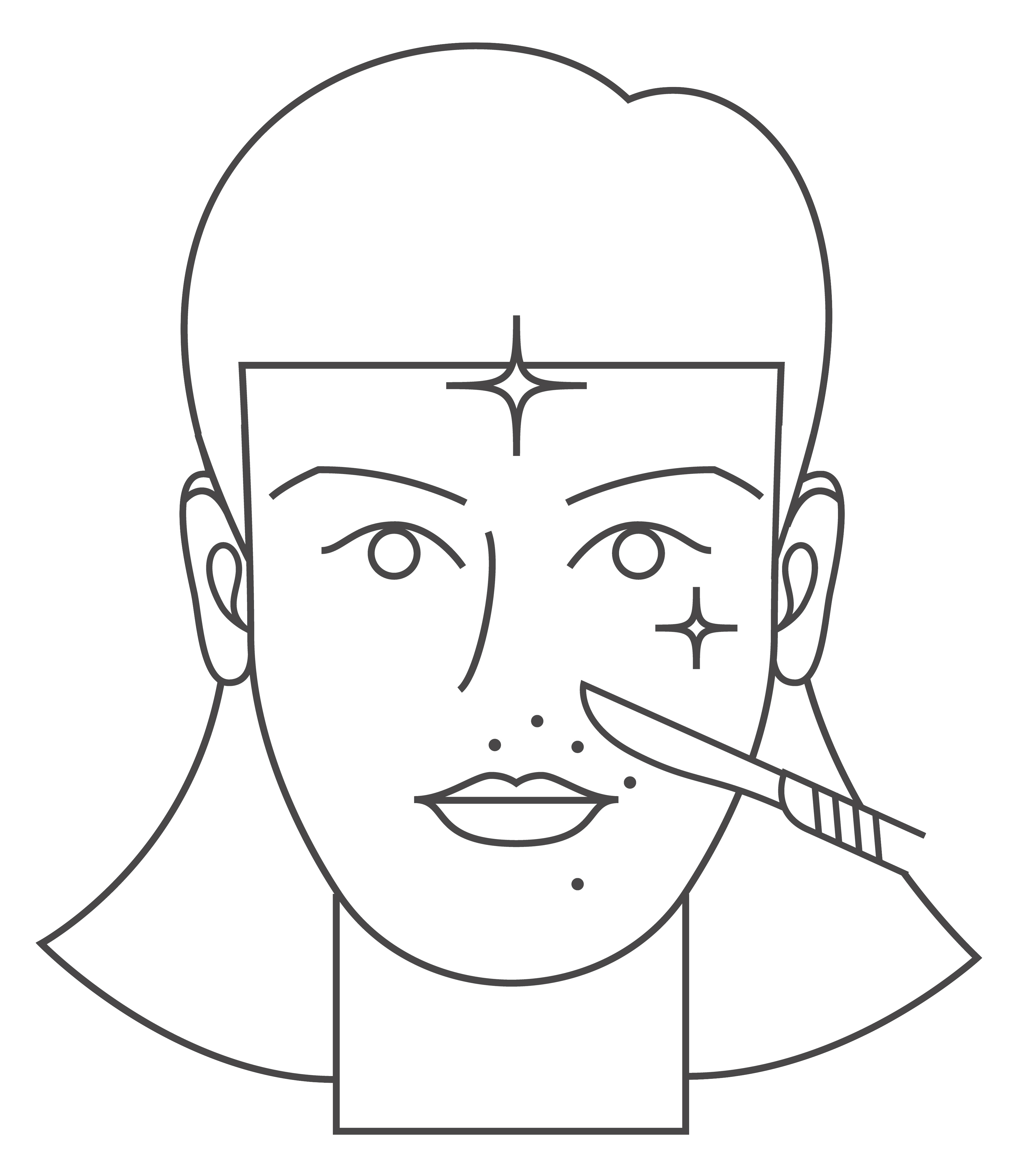
FAQs
Click on a topic below
to see our FAQs!
Consultations
& Appointments
Yes! Each treatment will be customized to fit your unique body and facial anatomy. Since we do not treat patients as “one-size-fits-all,” our aesthetic provider will meet you in person to review your treatment plan. Even if you have had the treatment done in the past, a consultation is required. The consultation allows us to examine, evaluate, explain, and educate our patients.
The consultation fee is collected during your initial consultation.
All consultations are in person so the provider may closely examine and evaluate you to make a more accurate assessment and plan. It allows you to see the office and before and after images.
This is the most popular question we are asked, and we understand how important it is to budget finances properly for a procedure. Given the complex nature of aesthetic procedures and that each patient’s features are uniquely different, pricing and candidacy vary and can only be determined upon an evaluation. The fee will be discussed following an examination.
Consultations typically last between 20 and 30 minutes.
We are partnered with CareCredit to offer our patients a payment plan for dermatological, non-surgical, and minimally invasive cosmetic treatments and procedures.
The majority of procedures in our office are not covered and require payment out of pocket. However, you can check with your insurance provider before your scheduled appointment.
We accept all major credit cards, cash, and CareCredit as a method of payment. Check payments must be pre-paid a week in advance.
Yes! Our office staff will send you a text message two days in advance and on the morning of your scheduled appointment.
Botox
It is the most trusted product and is FDA approved to treat three areas of the face at the same time: the forehead, the frown line, and the crow’s feet.
We prioritize patient retention and happiness at Essential Aesthetics. We’ve discovered that Botox produces consistent results at every appointment, and our patients are pleased with the results.
In general, patients in their mid to late 20s every six months, and patients in their mid to late 30s or beyond roughly three times a year.
Our goal is to educate our patients about the need of receiving therapy in numerous places because injecting one set of muscles and not another might upset the natural balance, resulting in brow droopiness or unsatisfactory results.
We typically prescribe 64 units three times a year to treat three areas of the face. Typical units for frontalis lines (20 units), Lateral canthal lines or crow’s feet (24 units), and Glabellar or frown lines (20 units).
Botox Cosmetic typically lasts 4-6 months. We recommend at least three Botox visits per year to assess progress and address other aesthetic treatments such as dermal fillers and laser resurfacing.
Following botox injections, you will receive a follow-up text the next day and another text 10 days later. Your next botox visit will be scheduled three to six months after your treatment.
Our appointment includes a full facial evaluation, not just lines, and wrinkles. Our primary focus is on the issue that you are most worried about. The consultation comes with a fee.
The provider considers areas that Botox Cosmetics does not address, such as the cheeks, chin, jawline, lips, and nose, because all of these factors contribute to balanced, natural-looking facial characteristics.
Our provider provides you with an estimate based on specific therapy and recommendations, which will be discussed at your consultation and before each session.
Aesthetic neurotoxins can help temporarily improve the appearance of moderate to severe lines in certain areas of the face, such as moderate to severe forehead lines, frown lines, and crow’s feet in adults.
Once injected into the treatment area, they work to temporarily block the muscle contraction, which causes the muscle activity to decrease and the appearance of wrinkles to reduce.
You may begin to see results within a few days, with increasing improvement in one week and full results in several weeks. Retreatment should be no sooner than every three months.
Fillers
Injectable dermal fillers are approved treatments that temporarily add volume to certain areas of the face, including the cheeks, lips, or nasolabial folds.
Essential Aesthetics uses Juvederm collection of fillers, Restylane family fillers, and Sculptra.
The number of fillers you need depends on the area being treated and your desired results.
Dermal fillers will essentially smooth fine lines and replenish lost volume for a more youthful appearance. Fillers can have many advantages such as plumping thin lips, enhancing and filling shallow areas of the face, decreasing shadows or wrinkles under the eyes, and filling in or softening recessed scars or static wrinkles.
Injectable fillers can last anywhere from one year up to two years. How long dermal fillers last can depend on your injector technique, the product injected, and the area of the face treated.
Dermal fillers will not cause sagging. Dermal fillers are mainly used to replace lost volume as we age. Losing volume of dermal filler is similar to losing volume from aging or weight loss.
Common side effects include bruising, swelling, redness, and tenderness at the injection sites. These typically resolve after a few days to a week. We recommend avoiding blood thinners such as Advil and Motrin before and immediately after treatment to reduce the chance of bruising occurring.
Injectable dermal fillers are made from a range of different substances, but the primary ingredient in most injectable fillers is hyaluronic acid, a water-loving molecule found naturally in the skin. A modified form of HA serves as the backbone of many clear, colorless, gel-like injectable fillers, which are injected under the skin to add volume to areas such as cheeks, lips, and facial wrinkles and folds.
Chemical
Peels
A chemical peel, also known as chemexfoliation or dermapeeling, involves the use of a chemical solution to enhance the appearance of your skin. In this treatment, a chemical solution is applied to the patient’s skin, causing trauma or injury to the skin’s layers. Eventually, the skin layers will peel away, revealing younger skin. The new skin is typically smoother, with fewer lines and wrinkles, a more brighter color and a glowing complexion.
On the skin, a chemical solution is applied. Typical chemical solutions consist of glycolic acid, trichloroacetic acid, salicylic acid, lactic acid, and carbolic acid. Each type of chemical causes a controlled injury by penetrating the skin to a different depth and then peeling away to expose a new layer of skin.
Different chemical solutions produce distinct outcomes. The choice of chemical depends on the desired result. Your provider and you will determine the depth of your peel.
A chemical peel can treat a variety of skin conditions without the need for surgery. It can eliminate acne scars, sun damage, creases, crow’s feet, and mild sagging. If you have any of the following skin conditions, you may be a suitable candidate for a chemical peel.
Chemical peels are categorized according to the depth of penetration of the peeling solution into the skin. There are light, medium, and deep chemical peels. The results will be more significant the deeper the peel is. However, this results in a longer recovery period. It is preferred to choose a peel based on your skincare needs rather than healing times.
A superficial chemical peel eliminates the epidermis (outermost layer of skin). It is utilized for the treatment of fine lines, acne, inconsistent skin tone, and dryness.
Impact the middle layer of your epidermis, known as the dermis. This layer extends from the papillary dermis to the reticular dermis’s intermediate layer. Medium-depth peels are considerably more effective at removing dead skin cells and reducing scarring.
Deep chemical peels provide an intensive exfoliation with long-lasting results. Deep peels are an aggressive method of skin resurfacing that enhances the skin’s appearance. A solution is applied to the skin, causing the treated area to exfoliate and “peel off” In general, the deeper the peel, the more dramatic the results; however, deeper peels are also associated with lengthier recovery periods and negative side effects.
- Since superficial or light peels are used to exfoliate the outer skin layer, you may only experience some slight stinging while the chemical solution is on your skin.
- A mild peel reaches the second layer of skin, the intensity increases slightly. You may experience mild burning immediately after application. It is common for it to last during the entire procedure and into the immediate healing period.
- To remove the deeper layers of skin, the most extreme chemical peels use phenol, a potent acid that can penetrate deeply into the skin.
These peels are generally done under general anesthesia because of how painful they may be.
Peeling typically begins 48 to 72 hours after treatment and can last 2 to 5 days. It is vitally essential not to pick at skin that is peeling; peeling is minimal and can be easily controlled with moisturizer. Peeling the skin prematurely will result in dry, porous, raw skin, which may develop hyperpigmentation.
Chemical peels do not require major downtime; however, you should avoid sun exposure as much as possible while your skin is healing. During the first week following a chemical peel, your skin may be temporarily more sensitive to the sun; therefore, you should remain in the shade and hydrate your skin. Similarly, avoid peeling and scraping the skin after a chemical peel, as these actions may result in scarring.
CoolSculpting
Our certified CoolSculpting specialists will perform your treatment.
At our clinic, we approach CoolSculpting with a “Fire and Ice” method. After the CoolSculpting procedure is done we follow up with an RF massage which helps tighten and contour the skin after treatment.
CoolSculpting permanently reduces fat cells but cannot prevent the formation of new ones. Ideal for patients who can commit to healthy habits to maintain results.
CoolSculpting is a non-invasive and non-surgical treatment that requires no recovery time.
The number of cycles needed would depend on the patient’s body fat composition and personal concerns. During your consultation appointment, our medical provider will conduct a full assessment of the treatment area to develop a treatment plan that best meets your personal goals.
CoolSculpting can eliminate up to 15-20 percent of fat cells in a given area.
You will begin seeing results as early as 4 weeks after treatment and with optimal results within three months.
The body’s lymphatic system will naturally and gradually dispose of fat cells and the skin will gradually return to normal.
Kybella
Kybella is an FDA-approved injectable treatment that destroys fat cells under the chin to improve your profile. Kybella is identical to something in your body called deoxycholic acid which helps absorb fat.
The process should be repeated every 1-3 months with noticeable differences after 12 weeks or at least 3-5 sessions.
It’s commonly used for the double chin, but Kybella can also be used to treat stubborn fat in the armpits, jowls, and brat fat. Although these uses are not FDA approved, it is up to your aesthetic provider’s discretion.
Kybella kills fat cells so fat won’t come back in the treated area. Same with liposuction, if you normally gain weight it may come back in a new area.
Avoid alcohol, caffeine, niacin supplements, high sodium foods, high sugar foods, refined carbs, spicy foods, and cigarettes for at least 24-48 hours after treatment.
With a single treatment, patients can see a reduction in fat as much as 20-30 percent.
Submental fat that ranges from moderate to severe, the absence of platysmal or neck bands, and high skin turgor.
Someone with insufficient fat under the chin, prominent platysmal bands, a lot of fat around the ear, anticoagulant therapy, and a history of dyslipidemia
The provider takes a series of facial impressions from patients to assess digastric muscle and the extent of the patient’s submental fat. In addition, patients will be asked to move their necks against resistance to evaluate the lateral margin of the approved treatment area; skin marking will follow this exercise.
The starting dose is approximately three vials for every 30 dots on submental fat marking, and each treatment area can receive up to 5 vials.
To reduce swelling, it is recommended that you wear a chin strap with an ice pack for a few nights after treatment and elevate your head. Patients may experience numbness, redness, nodules, bruising, and firmness at injection sites after treatment, which usually resolves in 4-5 weeks. Icing the chin and neck is critical for reducing inflammation. Take Tylenol for the first 24 hours, avoid strenuous exercise for 48 hours, and avoid salty foods.
Kybella is a medication that permanently destroys fat and typically requires two to four treatments, with a maximum of six to see final results. These treatments should be repeated every 4-8 weeks.
Platelet-Rich Plasma
Platelet Rich Plasma (PRP) is an injectable treatment where a patient’s own blood is used. The blood is drawn into a tube and then put into a centrifuge, where its different components, one being PRP, are separated. PRP contains healing growth factors that give instruction to your tissues to regenerate and multiply.
PRP can be used to treat hair loss, fine lines, and wrinkles, skin laxity, as well as skin texture and tone.
The platelets are a component of blood that is extracted into more concentrated platelets to inject into the targeted area to accelerate healing. When using PRP injections for your hair it can increase blood circulation to stimulate hair growth and increase the thickness of the hair shaft.
Patients can notice results after just 4 to 6 treatments. However, it may take up to a year to see the most optimal results. It is recommended to space out your treatments 1 month apart.
Results of PRP will vary depending on the patient’s condition and results of initial treatment. It is suggested to have maintenance injections every 3 to 6 months once hair loss is contained.
There are several ways PRP can be used to treat skin concerns. It can be massaged into the skin after an RF microneedling treatment to help expedite the healing process of tissues. RF microneedling with PRP also addresses uneven skin tone/texture, large pores, facial laxity, and fine lines and wrinkles.
PRP can also be injected into the skin with dermal fillers or by itself. When injected into the wrinkles, PRP stimulates the production of collagen
RF
Lymphatic Massage
An RF lymphatic massage helps break down scar tissue post-liposuction or BBL and stimulates the body’s collagen to promote healing. It helps reduce swelling because it reduces fluid buildup, scarring, inflammation, and bruising.
It is recommended to wait at least 2 weeks before receiving an RF lymphatic massage.
RF lymphatic massages are usually comfortable and compared to a hot stone massage. Some areas may be more tender than others.
It feels like light pressure with the fingertips to re-open lymphatic channels and to move the fluid (swelling) back into these re-opened channels. It is a gentle experience.
For patients who have had tummy tucks or liposuction, it is recommended to start lymphatic massage 7-14 days after your surgery. This can help decrease any post-surgical swelling and speed up the recovery process.
A session usually lasts from 20 to 60 minutes, depending on the scope and scale
After the session you will notice you begin to feel better by about 50%, within hours after the massage you then feel 90% better. You may also feel incredibly rejuvenated, which can last for days after.
It is recommended to get a RF Lymphatic Massage every week with maintenance and follow up every 3-6 months.
RF Lymphatic massages can help to reduce the buildup of fluids, recovery time, scarring, inflammation, and bruising.
Sclerotherapy
Also known as “chemical ablation”, sclerotherapy is when a sclerosis agent is injected directly into the veins. A sclerosis treatment is a chemical that triggers a series of biological reactions that target the given area. The solution causes the vein to scar, forcing the blood to reroute to healthier veins
Sclerotherapy injections provide a faster resolution for problem veins, typically with fewer treatment sessions than with lasers. Sclerotherapy is a minimally invasive way to treat spider and varicose veins and reticular veins smaller than 1mm. Laser vein treatment may be a better option for you if you have spider veins on the face.
Sclerotherapy injections can begin to work immediately. Spider veins can fade away as soon as they receive an injection.
Radiofrequency (RF)
Treatments
It takes time for your skin to produce new skin cells, collagen and elastin. You should see changes to your skin tone and appearance within 2 to 6 months. Some people need 2 to 6 treatments.
Depending on your treatment goals, PA Ellie Zarnegar may recommend getting other nonsurgical cosmetic procedures during the same appointment. These treatments include: Microneedling, Dermal Fillers, or BOTOX.
Radio frequency skin tightening can give you the results of a facelift (rhytidectomy) without the need for surgery.
Radio frequency skin tightening is an outpatient procedure. It takes about one hour, depending on the treatment area. You go home soon after the procedure. The treatment area may feel warm. And you may experience tingling vibrations or mild discomfort. You should alert your provider if you feel an uncomfortable burning sensation.
Radio frequency devices use safe levels of low-frequency electromagnetic waves to generate heat. This heat penetrates deep into your skin’s layers. There, it stimulates new skin cell production (regeneration). The treatment also stimulates the production of collagen and elastin. These proteins give skin cells more strength and flexibility. As a result, sagging skin regains its firm shape and feel.
You can expect there will be some inflammation, swelling and redness like a sunburn that can last for 24 – 48 hours after the procedure. There may be some minor pinpoint bleeding and possibly some bruising. You will be advised on how to care for your skin during healing. It is important to wear sunscreen and avoid sun exposure while you heal. We also advise you to avoid applying makeup for 24 hours.
Good candidates must be in good health, have signs of skin aging and realistic expectations. RF Microneedling can treat all skin types and colors including tanned skin. People who have active cold sores, a skin infection, a skin disease such as psoriasis, are receiving chemo or radiation, take anticoagulant medications, are pregnant or have a history of poor scarring including keloid scars, or poor wounding are not good candidates.
After treatments, you will immediately see an improved facial appearance. You may experience some redness or swelling, depending on the course of treatment created for you by PA Ellie Zarnegar. This may last a couple of hours and up to a few days. In the following days, you may see and feel minor scabbing that will naturally heal and shed off. You may cover the area with some make-up. Each RF treatment takes about 30 minutes. Immediately after the treatment, you can return to your daily activities
This treatment is not suitable for patients with pacemakers, defibrillators, or any implanted electronic devices, as well as metal implants in the treatment area. Our provider will consult with you prior to choosing this treatment.
Microneedling uses fine, sterile needles to penetrate the skin, causing micro-wounds that stimulate the wound healing process and collagen production. RF microneedling combines radiofrequency energy with microneedling to amplify collagen and elastin production by reaching deeper layers of the skin. RF microneedling can treat more problems than traditional microneedling such as fine lines and wrinkles, scarring, pigmentation, skin laxity, and much more. RF microneedling is also a more customizable treatment because the puncture depth and RF energy can be adjusted from patient to patient.
RF microneedling can treat a variety of skin concerns including lines and wrinkles, pigmentation, pores, acne scarring, keloid scarring, stretch marks, skin laxity, texture, and much more.
RF skin tightening can treat lax skin anywhere on the body, cellulite, and wrinkles.
The number of treatments needed depends on the severity of the condition being treated and your overall aesthetic goals. Typically, patients need anywhere from 6-8 treatments to see optimal results.
It is recommended to come in every 2 weeks for RF skin tightening treatments and every 6 weeks for RF microneedling treatments.
RF skin tightening treatments are painless and are often compared to a hot stone massage. During your treatment, you will experience a warm, soothing sensation.
RF microneedling treatments are slightly more uncomfortable than the skin tightening treatment, however, a topical numbing cream will be applied prior to treatment to help with any discomfort.
Vitamin B
Injections
Vitamin B12 is an essential nutrient that is not produced in the body. It is mainly found in animal products such as fish, meat, poultry, eggs, and dairy. It is a water-soluble vitamin which means it is not stored in the body and must be replenished regularly.
B12 is an important vitamin for healthy nerve cells and can be used as a treatment for fatigue, insomnia, depression, chronic pain, herpes, anxiety, brain fog, and anemia. B Complex is a cocktail of different B Vitamins – B1, B2, B3, B5, and B6. It plays an important role in keeping our bodies running like a well-oiled machine by converting our food into fuel.
You may experience a small bruise or soreness at the injection site, which is normal and goes away within a few days. Pink or orange urine 1-2 days post treatment is normal. Although rare, you may experience an allergic reaction after treatment. These are typically easy to recognize and our medical providers are trained and prepared to treat any adverse reactions.
Everyone’s body responds differently after receiving a vitamin injection, but patients typically feel noticeable benefits within 24 hours.
The more depleted you are, the faster your body will go through the nutrients. Patients generally start by coming in twice a week, at the beginning of their treatment. After you begin to see an improvement in symptoms, it is recommended to come in weekly or twice a month.
Common signs to look out for Vitamin B deficiency include lethargy, headache, depression, irritability, weakness, fatigue, nerve pain, moodiness, cognitive decline, or tremors.
There are no contraindications with any medications.
Sculptra
Sculptra is an injectable that stimulates and replaces lost collagen, restores fullness and refines the appearance of folds and wrinkles.
Sculptra can be injected in the nasolabial folds (smile lines), temples, cheeks, marionette lines, chin, jowls, jawline, neck, and acne scars for facial rejuvenation. Sculptra can also be injected in other areas of the body including the arms, upper knees, decolletage, buttocks, hip divets, and areas of cellulite. In male patients, Sculptra can be used for augmenting calves, pecks, and biceps as well.
Patient results may vary since Sculptra uses your own body to stimulate collagen. Typically, patients may see results starting at 6 weeks.
We advise avoiding aspirin, garlic supplements, green tea, flax and fish oil, vitamins A and E, and essential fatty acids as they might increase the chances of bleeding and bruising.
We recommend that after Sculptra our patients massage the area for 5 minutes, 5 times a day for 5 days to help disperse the treatment and to avoid any collagen from clumping.
Sculptra adds volume by stimulating collagen production and does not affect fat metabolism.
In general, patients require about 3 treatment sessions to achieve desired results. They are spaced out 2 to 4 weeks apart. The number of treatment sessions you need depends on your skin condition and your desired outcome.
Our aesthetic professionals will determine the ideal number of treatments you will need to help you reach your goals.
Yes. Lumps are a normal side effect of Sculptra. It is important to follow the Rule of 5’s after your treatment to prevent lumps as much as possible: Massage the area for 5 minutes, 5 times a day, for 5 days. If lumps do occur, they can be removed with a steroid injection administered in the office.
The number of vials may vary depending on the area of the body that is being treated and the amount of correction desired. PA Ellie Zarnegar will create a customized treatment plan for you and it may require multiple vials to be injected a few weeks apart.
Vaginal Rejuvenation
Our clinic offers different vaginal rejuvenation procedures depending on the concern. We offer labial rejuvenation, G-shot amplification, and labial augmentation.
The upkeep varies for every patient. For labia augmentation, we recommend coming once a year and for patients who receive a G-shot amplification, it is recommended to come every 4-6 months.
Before the procedure, we apply a topical numbing cream for best comfort. However, there is little to no discomfort during or after the procedure.
There is very little downtime needed after vaginal rejuvenation. Patients are recommended to prepare to wear a tampon and refrain from any sexual activity for at least 4 hours after a G-shot treatment. Otherwise, patients are able to resume daily activities.
We advise patients to avoid drinking alcohol, strenuous activity, and sexual activity before or after the procedure.
Acne
& Acne Scarring
Inflammatory acne and non-inflammatory acne are the two main types of acne. However, inflammatory acne is more likely to grow severe and require serious treatment if left unchecked. Cystic acne is one example of acne that causes inflammation. Noninflammatory acne is characterized by pimples that are located closer to the skin’s surface and are not painful or inflamed. Comedonal acne (also known as whiteheads and blackheads) is a frequent kind of noninflammatory acne.
In most cases, acne will affect every person at some point in their lives. Acne occurs more frequently in teens and young adults because of hormonal changes, although it can also affect adults. If acne runs in your family, you may be more likely to experience it yourself.
Acne is extremely common, so you’re not alone if you have it. Acne is the most common skin issue worldwide. Between the ages of 11 and 30, acne affects an estimated 80% of adults.
Acne is most likely to appear on your face, forehead, chest, shoulders, and upper back. However, acne can also appear anywhere on your body. There are glands producing oil all over your body. Acne tends to appear in areas of the skin that have a high concentration of oil glands.
Acne is caused by clogged hair follicles or pores. Your hair follicles are tiny channels that contain individual hairs. Multiple organs drain into the hair follicles. A blockage occurs when too much material is present within the hair follicle. The following may clog your pores: sebum, bacteria, and dead skin cells.
At Essential Aesthetics, we offer fractional laser and IPL treatment to address acne. This treatment helps minimize the look of redness and acne scars, which are both common side effects of acne.
Acne scars can be removed using laser skin treatments, leaving you with skin that is smooth, healthy, and more visually pleasing. But even if your laser procedures are successful, you won’t be able to stop acne from appearing again if you don’t take precautions to prevent it. For example, you should wash your face twice a day, avoid touching your face, alter your diet, and pay close attention to what you consume.
Scarring from acne is caused by the inflammation and infection that occurs underneath the skin, despite the fact that acne frequently leaves visible signs of its presence on the surface of the skin itself. Inflammation is taking place underneath your skin whenever you have a breakout. Scarring is a result of the trauma that this inflammation produces to the skin tissue.
We recommend non-ablative treatment methods, such as laser resurfacing or PicoFractional, to patients who have scars that are rather minor and superficial. Patients who have scars that are deeper may benefit from an ablative treatment such as radiofrequency microneedling (RF microneedling).
New collagen is produced in the skin after laser treatment for acne scars, which helps to even out the skin’s texture. The outcomes are permanent. Acne scars can be temporarily treated using dermal fillers. However, dermal fillers do not remove or alter scars; they just make them less noticeable. However, the effects of dermal fillers only remain for about a year. Acne scars can be treated with dermal fillers for people who are prepared to keep us with the maintenance that is required.
Treating active acne is the first step toward preventing permanent scarring. That requires finding and using an effective treatment for your acne. Spots and markings may be easier to manage if the underlying cause is addressed. Scarring can be avoided in other ways, too: regular application of sunscreen, consideration of a topical retinol or retinoid, and avoiding heavy makeup.
The three different types of acne scars are:
- Boxcar scars – shallow to deep in depth with well-defined edges
- Rolling scars – undulations on the skin, shallow, measuring a few millimeters wide.
- Icepick scars – deep, severe, V-shaped scars that are narrow in length.
PDO Threads
Polydioxanone (PDO) threads are absorbable medical grade threads that are thinner than human hair and are used to tighten and lift drooping skin. Small needles or cannulas are used to implant these threads beneath the skin. After the threads are placed, the skin immediately appears younger, fuller, and elevated.
Your individual skin type, skin texture, and cosmetic objectives will be taken into consideration before your PDO thread lift is performed. It’s possible that you’ll get three or four precisely positioned barbed threads, but it all depends on the area you want treated. In order to achieve variable degrees of lift, skin tightness, and cellular renewal, different threads are utilized.
One of the many advantages of this treatment is that it may be completed in as little as 15 to 30 minutes. After that, you are free to resume working or engaging in whatever other activities you had planned for the remainder of the day.
Before beginning treatment, we will numb the treatment area with a topical numbing agent and then administer a local anesthetic to the area. The needle that will be used for the treatment is extremely fine, therefore it will not result in any discomfort.
Following the start of the anesthetic’s effects, the next step in the treatment will be carried out. Needles with sharp tips or cannulas with blunt tips are used to implant the PDO threads. Cannulas are the blunt-tipped needles. They serve as anchors once they have been put into the proper layer of skin, and this allows the skin to be pulled upwards. Any extra threads are then removed by cutting them.
This procedure has no health risks in any kind. The FDA has validated its effectiveness and declared it safe. In addition, there have been hundreds of thousands of treatments carried out, and no adverse reactions, sensitivities to the threads, or major side effects or hazards have been reported.
This treatment does not need a significant amount of unusual aftercare. However, you shouldn’t get any dental work done for at least two weeks after your PDO thread lift because the stitches will still be in place. It’s possible that the outcome of your treatment could be impacted if you keep your mouth open for an unusually long duration. In addition to this, it is recommended that you sleep on your back for the first two weeks.. This prevents you from placing an excessive amount of pressure on one side of your face.
After one to two months, you will experience the full effects of your PDO thread lift. Your age has a significant role in determining how long it takes you. The rate at which your body generates fresh, healthy collagen depends in a significant way on your age. Collagen is the protein responsible for enhancing your cheek fullness, masking wrinkles, and filling in fine lines.
The thickness and quality of the PDO threads, as well as your own metabolism, all play a role in how long they will last. However, after six to nine months, most clients report that the threads are no longer visible.
Almost every part of the face can be improved with a PDO thread lift. The neck, crows feet, cheeks, jaw, marionette lines, and other wrinkles on the face. Most patients want to have work done on their cheeks and lower face/neck area.
A PDO lift can smooth out fine lines and wrinkles around the mouth and nose while also lifting the eyebrows, cheeks, and jawline.
Your desired outcomes will determine which supplementary treatments will work best with your PDO thread lift. Neuromodulators are the most effective treatment for frown lines and creases caused by frequent frowning. Dermal fillers are a great addition to a PDO thread lift if you are primarily concerned about static lines and wrinkles.
HydraFacial
HydraFacial is an extremely well-liked advanced facial treatment. It extracts impurities and dead skin cells while simultaneously infusing the skin with purifying, hydrating, and moisturizing serums. The treatment is soothing, revitalizing, non-irritating, and highly effective.
The HydraFacial is revolutionary because it can address numerous skin issues with just one device. The goal was to create a therapy that would be as effective as chemical peels, manual extractions, and microdermabrasion, but without the discomfort or redness those other methods cause.
Depending on the area being treated, the duration of treatment is going to vary. Normal treatment time for the entire face is between 45 and 60 minutes. You can get immediate, long-lasting effects with this procedure, making it ideal for people in need of skin rejuvenation.
Yes! HydraFacial is entirely customizable.The treatment features 4 different exfoliating tips that provide a moderate to intense exfoliation. This allows us to personalize a patient’s treatment to his or her unique skin requirements and type. In addition, it gives us the freedom and flexibility to modify and adapt the patient’s ongoing treatment plan as their skin changes and begins producing the desired results.There are also a number of boosters you can add to your treatment to further customize it. Each is formulated with unique nourishing ingredients to restore your skin to its state of perfection.
- The Signature Hydrafacial experience is a 30 minute treatment and it’s best for clients with low-maintenance, problem-free skin. It includes our 3 classic steps: cleanse, extract, and hydrate.
- The Deluxe is 45 minutes and adds a personalized booster to target your specific skin concerns, as well as professional strength LED light therapy.
- The Platinum is 60 minutes and includes all of the above, as well as lymphatic therapy.
At Essential Aesthetics, we provide both the deluxe and the platinum facials for our clients!
Hydrafacials are effective on all varieties of skin. A Hydrafacial treatment is beneficial for people with all types of skin, including oily skin that is prone to acne, dry skin that is prone to flaking, and combination skin that has both types of skin. Even people with sensitive skin are able to enjoy multiple sessions safely!
We recommend that patients who are currently taking retinol or any other retinoid stop taking it one week before they are scheduled to undergo treatment with us. This helps to reduce the sensitivity of the skin prior to the session so that it can better receive the treatment.
We recommend that patients get a HydraFacial once every four to six weeks to get the most out of their experience with the HydraFacial, even though a single treatment can produce visible changes. Patients who receive continuous therapy are able to address a variety of issues, including acne, hyperpigmentation, wrinkles, and an uneven skin tone.
Expect immediate and visible improvements on the texture and tone of your skin post treatment. The HydraFacial glow typically lasts approximately around one week, making it the ideal treatment prior to an event or vacation. However, if you wish to experience long-term benefits, we advise that you receive regular treatments.
No! There is no downtime period, and the only minor side effect is some redness at the extraction sites, which often fades away within a few hours. After your treatment, you should stay out of the sun. Instructions for sun protection will be provided in further detail.
This treatment is ideal for acne-prone skin because it thoroughly cleanses pores without dehydrating the skin. With the revolutionary “Vortex-Fusion” device, the skin is hydrated while acne-causing debris is vacuumed out of the pores, resulting in an amazing glow. Following the treatment, we apply a Red LED light to your face for 20 minutes to reduce inflammation while offering additional anti-aging benefits. Multiple varieties of acne-causing bacteria can collect in your pores and oil glands and be killed by the Red LED light. In addition, it is very relaxing.
HydraFacial is not limited to facial treatments; it may also be used on the neck, decolletage, and backs of the hands (especially beneficial for individuals with acne or clogged pores), as well as the upper back and shoulders.
A DiamondGlow Facial is much more than a simple facial. In contrast to traditional wet facial treatments (Microdermabrasion – sandblasting with aluminum oxide crystals, Hydrafacial – glycolic and salicylic acid for chemical exfoliation), DiamondGlow’s patented, recessed diamond-tip wand provides a non-invasive resurfacing treatment that removes the stratum corneum, the dead outer protective layer of the skin.
During your treatment, your provider will pass a handheld Diamond Glow device over your skin’s surface. The device utilizes vacuum pressure to produce controlled and consistent suction on the skin’s surface, extracting dirt and debris from clogged pores. The three-in-one system simultaneously exfoliates and infuses medical grade serums into the skin. By promptly infusing the skin, Diamond Glow treatments offer the greatest level of penetration possible, resulting in greater outcomes and healthier skin.
While both DiamondGlow and microdermabrasion eliminate a portion of the stratum corneum, DiamondGlow is more consistent and controlled in its operation.
Similar to sandpaper, microdermabrasion blasts particles at the outer layer to remove the top layer of skin. DiamondGlow employs the constant vacuum pressure of a diamond-tipped vacuum wand to draw skin into a chamber within the wand.
DiamondGlow distributes the serums at the dermal-epidermal junction, resulting in a significantly deeper delivery than HydraFacial, whose serums only reach the surface of the skin. In addition, DiamondGlow is superior in terms of its ability to exfoliate, extract, and infuse serums because it penetrates deeper dermal layers. In comparison to the HydraFacial, whose benefits begin to diminish after a few days, this aligns to more significant results that last for a longer period of time.
A standard appointment lasts approximately 30 minutes. In addition to tailoring the treatment to the individual, additional add ons may be recommended.
There is no downtime associated with the Diamond Glow treatment; however, skin may appear flushed or pink immediately after the procedure, but this will shortly subside. Although all exfoliation causes temporary sensitivity due to the exposure of fresh skin, the treated skin becomes smooth but not irritated. For 48-72 hours after treatment, avoid heat, sun, showers, swimming, jacuzzis, and any abrasive or active products.
Yes! Using a diamond-tipped wand, the Diamond Glow Facial eliminates deficient and damaged skin cells, acne, and blackheads to expose a new layer of smooth skin cells.
Following treatment, the majority of patients notice an immediate improvement and a revitalized complexion. This procedure can increase the skin’s volume by as much as 70 percent, resulting in a visibly plump and youthful appearance.
Microneedling
SkinPen is the only microneedling device authorized by the FDA. Microneedling is a minimally invasive skin rejuvenation technique that helps reduce the appearance of aging, acne scarring, and aging skin.
The controlled micro-injuries caused by the SkinPen microneedling device stimulate the body’s natural wound healing process. Micro-injuries induce the release of hormones and growth factors, which result in reconstruction of tissue and the production of new collagen and elastin.
SkinPen is suitable for all ages and skin types of patients. If you are interested in reducing the appearance of fine lines, creases, and acne scars, as well as rejuvenating tired-looking skin and achieving overall skin tightening, SkinPen is the treatment for you!
Active facial infections, eczema, psoriasis, and atrophic scarring from chickenpox. In addition, individuals with open lesions should not utilize skinpen microneedling. This is due to the fact that it can lead to additional complications, such as infection and worsening of the incision or sore.
The SkinPen’s ability to adjust the depth of its needles makes it suitable for usage on a wide variety of areas of the body, including the face, neck, and chest.
You may feel some discomfort during a SkinPen treatment, but it won’t last long or be too uncomfortable. After a SkinPen treatment, most patients experience little pain at most. However, certain areas may be more sensitive than others, and this will vary from patient to patient.
For best results, we recommend scheduling four to six microneedling sessions, each one four to six weeks apart. However, the total number of treatments required is highly variable and will be based on your particular goals and skin’s current health.
Each patient will have a unique timetable for recovery. Typical symptoms include minor swelling and redness/pinkness (similar to a mild sunburn) for two to four days. Some individuals may have full recovery in just one day.
Patients may immediately observe healthier-looking skin. However, your skin’s natural repair process continues to progress over the course of several weeks. Damage sustained over an extended period of time will not vanish immediately.
Patients can typically resume their normal makeup routine 24 hours after a SkinPen procedure, depending on the treated area and procedure type.
SkinPen is not recommended for pregnant or women who are nursing.
Hydrafacial Keravive
Hydrafacial Keravive Scalp Therapy has gained widespread popularity. This innovative treatment combines hydra-dermabrasion technology with a specially formulated Keravive Peptide Complex Solution to thoroughly cleanse, hydrate, and nourish the scalp, resulting in healthy, radiant hair.
To cleanse and exfoliate, the service provider will direct the wand along your hairline and work in small sections across your scalp to eliminate buildup and dead skin cells and stimulate circulation. Gentle suction and a constant flow of water produce an invigorating sensation and prepare the scalp.
Once the scalp has been thoroughly cleansed, the Keravive Peptide Solution is distributed all over the scalp using a different wand attachment. This serum contains nourishing hair growth-promoting proteins and growth factors.
Those with flaking, itching, dry, or irritated scalps may benefit from a HydraFacial Keravive treatment. It’s beneficial for those getting ready for a hair transplant, using Rogaine, Propecia, Platelet-Rich Plasma, or Laser Therapy for hair loss, or experiencing hair thinning or loss due to hormonal, environmental, or physiological reasons including stress.
The typical length of time spent in treatment is between 30 min. to 45 min. The actual time required can vary from person to person based on variables like hair’s length, thickness, and condition.
After the Hydrafacial Keravive Treatment, wait 24 hours before utilizing hair style products or heat tools. This promotes the scalp to fully absorb the serum and enhances recovery and healing. Avoid touching the scalp or using strong or abrasive products that could irritate or harm the treated area. After 24 hours, you can restart your hair care routine and enjoy the treatment’s advantages, including scalp health, hydration, and hair growth.
After your HydraFacial Keravive treatment, start using the Keravive take-home spray every day. Once a day, with the nozzle held close to the scalp, spray 1-2 times per affected area. Once you’ve sprayed the solution onto your scalp, take 30-60 seconds to massage it in. If you want the best results, use the solution at night and leave it on your scalp all night.
No. Some patients may experience minimal hair loss as non-growing (vellus/peach fuzz) hairs are gone, but this indicates that the health of your scalp is improving.
After a Hydrafacial Keravive treatment, no special shampoo or conditioner is necessary. Using shampoos and conditioners with AHA/BHA or exfoliating properties will increase the effectiveness of your scalp treatment.
If you have already been diagnosed with scalp skin cancer, you should avoid any cosmetic procedures, including the Hydrafacial Keravive Treatment, on the affected area. The treatment involves extensive scalp exfoliation and massage, which may aggravate cancerous cells and cause additional damage.
The treatment is safe for clients with seborrheic dermatitis, and clients with this condition may find that the HydraFacial Keravive scalp treatment reduces flaking.
Dermaplaning
Dermaplaning is a procedure in which a medical scalpel is used to delicately exfoliate the top layer of dead skin cells and remove fine facial hair, also known as “peach fuzz” or “vellus” hair. It can be used as an alternative to laser and microdermabrasion treatments, or in combination with them for an enhanced effect. This procedure will make your skin appear more radiant. After the treatment, it is easier to apply makeup and other skincare products are able to penetrate the skin more deeply, making them more effective.
At a 45-degree angle, the skin specialist will glide a medical-grade precision blade across your face. This will take between 20 and 30 minutes. Following the treatment, your provider will apply a nourishing mask to hydrate and protect your newly radiant skin. Additionally, we apply sunscreen to prevent damage to your newly treated skin from the sun’s harmful rays. You will feel no discomfort throughout the procedure.
Dermaplaning works best on people who have mature, dry, rough, or uneven skin. Acne scars, wrinkles, and hyperpigmentation that are close to the skin’s surface might all benefit from a dermaplaning treatment.
Dermaplaning is acceptable for most skin types, however it should be avoided by persons who have highly sensitive skin, severe acne outbreaks, or inflammatory skin diseases such as rosacea or eczema. Dermaplaning is also not recommended for pregnant or nursing women. In these circumstances, dermaplaning may cause the skin to become more irritated and may even spread an infection.
Certainly not! We cannot perform dermaplaning on the lower portion of your face and neck if you have a beard, but we can treat the remainder of your face and neck. Moreover, this treatment is ideal for men with folliculitis and can be combined with a chemical peel and LED Light Therapy.
During dermaplaning, the skin’s surface is gently scraped in order to achieve the desired results. Most people associate pain with hair removal methods like waxing and threading, but Dermaplaning is completely painless. Minor cuts to the skin are possible during Dermaplaning, however the pressure applied is not enough to cause a deep cut. Minor cuts and scratches like these normally heal within 24-48 hours.
You can get this treatment every three to four weeks. Due to the fact that the treatment itself eliminates the equivalent of 21 days’ worth of dead skin, it is recommended that you wait at least that long before scheduling another session.
Overall, dermaplaning is better. Shaving only removes facial vellus hair, also known as “peach fuzz.” Professional dermaplaning, despite the fact that it can also eliminate vellus hair, is primarily an exfoliation treatment for the epidermis. The process of dermaplaning removes skin cells that have been damaged by environmental toxins, irritants, and sun exposure. Consequently, it has the additional benefits of smoother skin and a hairless, more radiant complexion!
Exfoliation of the skin can be achieved using either method. Microdermabrasion also exfoliates the surface of the skin, although it does not do it as fully or deeply as dermaplaning does. Vellus hair, commonly known as peach fuzz, and dead skin cells are removed from the skin during the dermaplaning procedure.
No. On the body, there are two distinct forms of hair: vellus hair and terminal hair. Vellus hair is present on the majority of the body, except the palms, soles, lips, and genital regions, whereas terminal hairs are located on the scalp, underarms, and pubic region. Vellus hair regrows at the same rate and with the same texture.
Dysport is a medication that is administered by a licensed healthcare professional. It is supplied in a single-use, sterile 300-unit vial. When used to treat glabellar lines (frown lines between the eyebrows), a total of 50 units of Dysport is injected equally among the specific muscles. It’s important to note that the dose of Dysport is different from the dose of any other botulinum toxin product and cannot be compared to the dosage of any other botulinum toxin product that you may have previously used.
A single treatment of Dysport may offer results that can last for up to 5 months.
Results can be seen in as little as 24 hours, with over half of users seeing improvement in frown lines between the brows within 2–3 days.
A licensed healthcare professional administers Dysport, an injection that temporarily reduces the appearance of frown lines in adults under 65.
AbobotulinumtoxinA is a neuromuscular blocking agent that temporarily inhibits muscle movements, causing frown lines, by inhibiting acetylcholine release.
The length of office visits may differ, but typically the procedure takes around 10 to 20 minutes.
The most common side effects include nose and throat irritation, headache, injection site pain and skin reaction, upper respiratory tract infection, eyelid swelling and drooping, sinus inflammation, and nausea.
Dysport and Botox are both derived from botulinum toxin type A. They work in a similar way by blocking the release of acetylcholine (ACh), which prevents the muscles from contracting and maintains the aesthetic effect. However, it’s important to note that the dosage of Dysport cannot be compared to any other botulinum toxin product that you might have used before. Each product has a unique dosage that should be followed for safety and effectiveness.
Your healthcare provider will determine the cost of Dysport based on the frequency of injections and the amount of product used. The price of Dysport is comparable to other botulinum toxin products available in the market.
We invite you to join our loyalty program, ASPIRE Galderma Rewards, to earn rewards, bonuses, and discounts on any and all Galderma facial anesthetic treatments, including Dysport!
Restylane is a complete range of injectable gels, both soft and firm, that are made of hyaluronic acid. This substance is naturally present in the body and attracts and binds water molecules to add volume. The results are immediate, as the gel adds volume to smooth out wrinkles and enhance facial balance, making you look revitalized and more youthful.
Restylane has an established safety profile with over 50 million treatments worldwide across more than 25 years of use, making it the most studied line of dermal fillers.
Restylane can be used to smooth wrinkles, soften facial lines, and enhance facial features, such as lips, cheeks, and jawline, by adding volume for fullness and definition.
Your healthcare provider will administer Restylane via injection and may perform a gentle massage of the treated area afterward.
A Restylane treatment is usually quick, with an optional touch-up to optimize results.
For some people, Restylane may cause mild discomfort during treatment. However, many Restylane products have an integrated local anesthetic called lidocaine, which can make the experience more comfortable.
It’s essential to inform your Restylane provider about any current or prior medical conditions and allergies, the severity of these conditions, all medications you are taking, and any planned or previous aesthetic procedures. This information will help your provider determine whether Restylane is suitable for you or not. Keep in mind that Restylane may not be appropriate for everyone, and there are certain people who should not use it. Therefore, it’s crucial to be transparent and provide accurate information during your initial consultation.
Inform your provider if you are pregnant or breastfeeding before receiving treatment with Restylane products.
A Swedish division of Galderma called Q-Med produces the dermatology product Restylane.
Results may vary with each patient, but a repeated treatment plan can lead to long-lasting results.
Maintenance or “touch-up” treatments refer to one or more additional sessions after your initial treatment to help sustain your desired results. Kindly consult with your provider to determine if a maintenance treatment is appropriate for you, and to discuss the recommended frequency and amount of Restylane to be applied.
The most common side effects after injection include swelling, bruising, redness, pain, and tenderness. These effects usually disappear within a week.
Radiesse and Radiesse (+) are dermal fillers that have been approved by the FDA to smooth out moderate to severe facial wrinkles and folds, including the nasolabial folds (the creases that extend from the corner of your mouth). In addition, Radiesse can be used to correct volume loss in the back of the hands.
Radiesse is injected under the skin in a quick procedure that can be done over the lunch hour.
Upon injection, Radiesse smoothes lines and wrinkles for natural-looking results lasting over a year in many patients.
Common side effects of Radiesse or Radiesse (+) include bruising, redness, swelling, pain, and itching at the site of injection.
To get more personalized information, the best thing to do is to schedule a consultation with our office or visit our Radiesse page!
Latisse is thought to enhance the growth cycle, or anagen phase, of your eyelash hair cycle. The anagen phase is the growth phase for all hair. This means that Latisse can increase the length of the anagen phase and the number of hairs in this growth phase.
LATISSE promotes gradual lash growth with full results in 16 weeks. Lengthier lashes may appear after a month, but results may vary.
LATISSE is the first FDA-approved product for inadequate or insufficient lashes. It has been clinically tested for its safety and effectiveness in growing longer, fuller, and darker lashes.
Eyelash hypotrichosis refers to inadequate lashes in terms of length, thickness, or number.
LATISSE is a type of ophthalmic solution that is designed to promote the growth of eyelashes. If any solution accidentally makes contact with your eyes, there is no need to worry as it is not expected to cause any harm. Please avoid applying LATISSE directly into your eyes or onto your lower eyelid. It is also important to note that LATISSE is not an eye drop and should not be used as such.
The most common side effects of using LATISSE solution are eye itching and redness.
LATISSE usage may result in a permanent increase in the iris’s brown pigmentation, although this is very rare.
Although it is a frequent concern, eyelid skin darkening is actually an infrequent side effect. According to a study conducted for FDA approval, approximately 2.9% of patients using LATISSE experienced localized skin darkening. This occurs due to an increase in melanin near the area where the solution is applied and is expected to reverse within several weeks to months after discontinuing the product.
Discontinuing the use of LATISSE will result in a gradual return of your lashes to their original appearance over several weeks to months.
If you miss a dose of LATISSE, skip it and apply the next evening as scheduled.
LATISSE is not a replacement for mascara, but rather a prescription treatment to enhance lash growth for those with inadequate or insufficient lashes.
LATISSE is not suitable for those allergic to bimatoprost or any of its ingredients. If you have glaucoma, you should inform your ophthalmologist that you are using LATISSE.
Remove contact lenses before applying LATISSE. Wait 15 minutes after applying LATISSE before putting them back in.

